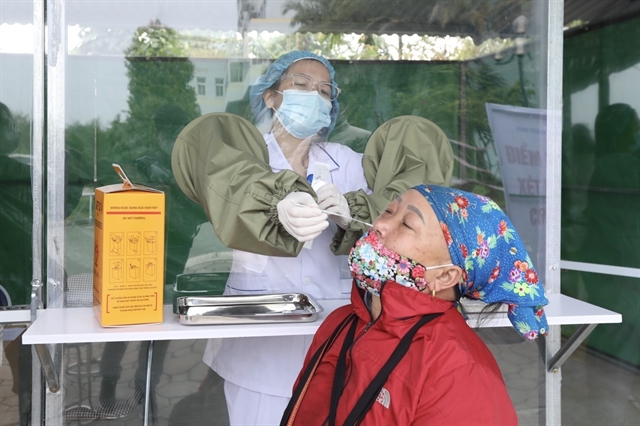 Society
Society

Narrowing the gap in hospital care is vital to ensuring that everyone has equal access to medical facilities. Yên Bái Province has been focusing on deploying new and specialised techniques that bring practical benefits to all patients.

|
| A medical worker takes a sample for COVID-19 testing at the Yên Bái General Hospital. — VNA/VNS Photo Minh Quyết |
YÊN BÁI — Narrowing the gap in hospital care is vital to ensuring that everyone has equal access to medical facilities. Yên Bái Province has been focusing on deploying new and specialised techniques that bring practical benefits to all patients.
Now they can access high-quality health services right in their hometown.
The Yên Bái General Hospital recently received a 61-year-old male patient who had severe chest pain, who complained that it felt as though his heart was being "strangled."
Through the results of subclinical tests and X-rays, doctors diagnosed that he had an acute myocardial infarction. He was transferred to a cardiovascular intervention room with DSA machinery.
It was found that he had a complete occlusion of the anterior artery, which was immediately treated.
Doctor Trần Văn Lâm said that the procedure lasted 20 minutes. The doctors discovered that the patient had 90 per cent stenosis of the right coronary artery. The second treatment followed one month later.
Lâm said that before 2020, when the province did not have the DSA machine, all patients with these symptoms had to be moved to Hà Nội. The journey took three to five hours, which increased the danger the patients were in.
However, thanks to professional help from top experts from Bạch Mai Hospital, doctors of the hospital have mastered the technique of vascular treatment on the DSA machine.
Now, on average, the hospital conducts vascular treatment for 30-40 patients a month.
Trần Lan Anh, director of the Yên Bái General Hospital, said that central-level hospitals are being supervised closely to ensure pandemic prevention and control.
“We work with central-level hospitals to register hospital transfers, so patients can be transferred as efficiently as possible. We use high-quality techniques to make the process as seamless as possible," she said.
The hospital currently has implemented many new techniques and cooperated with central hospitals to implement a number of effective and highly specialised techniques.
They routinely perform continuous dialysis, artificial dialysis, plasma exchange, fibrinolytic treatment techniques, treatment of septic shock and multi-organ failure.
The hospital is equipped with and has mastered the techniques of vascular treatment on the DSA machine, treatment of liver tumours, splenic trauma and varicose with laser treatment.
Local doctors have performed craniocerebral surgery, brain tumour, endoscopic surgery to remove an intracranial hematoma, spine surgery and microsurgery.
However, improvements are not just limited to provincial hospitals; district hospitals have also improved their quality.
Thanks to training from doctors in the Emergency Aids Ward under the Bạch Mai Hospital, since the middle of 2018, the Nghĩa Lộ Town General Hospital in Yên Bái Province has mastered the fibrinolysis technique and saves more than ten patients a year.
A 64-year-old female patient from Văn Chấn District, who was suffering from brain infarction and was hospitalised last Wednesday night, was one of many patients who were saved by local doctors.
Her son said that near midnight, he took his mother to the Nghĩa Lộ General Hospital, 25km from home, as she was slurring her words and her body had weakened.
Doctors gave her drugs to treat the cerebral infarction and put her under continuous supervision.
By Thursday morning, her blood vessels were re-opened and a day later, she was in full possession of her senses.
Doctor Giàng A Vừ, who treated the patient, said when patients suffering from strokes, cerebral infarction or cerebral haemorrhaging in Nghĩa Lộ Town, they had to be moved to Hà Nội. It took at least three and a half hours because of the distance. This was precious time that could make all the difference.
Nguyễn Trọng Khoa, deputy director of the Agency of Health Examination and Treatment under the Ministry of Health, said that quick response was very important. In fact, it is often key to saving a patients life.
By visiting hospital when initial symptoms appear, stroke awareness in the community has improved too.
Khoa said this was good because, after a short time of deploying remote medical support system, the Nghĩa Lộ and Yên Bái general hospitals could give better treatment. If patients must be transferred to a higher-level hospital, the possibility of saving their lives was very low.
In addition, through a distance learning programme, health workers in the provinces are updated with new knowledge and new information about drugs, guided by leading experts. They can also participate in consultation sessions about diseases and share their experiences with other doctors.
“This brings very high value because many people will benefit from these activities. We can hope that the gap between upper and lower-level hospitals will be narrowed, not only at provincial hospitals but also district and commune ones,” he said. — VNS